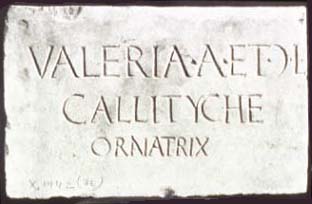

|
|
KM 1030: Funerary inscription (color)
|
KM 1030: Funerary Inscription (b&w) |
The epitaph reads "Valeria Callityche, freedwoman of Aulus and Gaia, a hairdresser."**
The funerary inscription, often mounted in a wall near where the sarcophagus would rest, serves as a tribute to the dead. The epitaph, written in Latin, tells us that after being freed from slavery, Valeria made herself known by becoming a hairdresser. Made out of marble, this commemorative marker serves as a reminder that while most freedwomen were of the lower class, it was still possible for them to become wealthy, and to mix with the Roman elite.
As a freedwoman, Valeria may have worked for someone with a great deal of money, or possibly earned enough to become wealthy on her own account. In either circumstance, a large amount of money was spent on her funeral, as demonstrated by her sarcophagus and grave goods. It is also possible that she fell into good favor with a Roman aristocrat who may have sponsored her - perhaps she even kept up ties with her old master.
Often tombstones and epitaphs are the only evidence that we have for the lives of Roman woman. They give us some insights into how women juggled their homes, families and occupations. Our lack of information about the lives of women in antiquity stems in part from the fact that they did not write about themselves, leaving us to read tombstones written for them and to make educated guesses about how people like Valeria Callityche lived their lives. We can also learn something about their social status from their funerals. The particular style of burial we see here was extremely costly and leads us to believe that Valeria was accomplished as a hairdresser and was able to make something of her life after being freed.**
**Please note: this "assemblage" was created solely for educational purposes. All of the objects discussed here are from entirely different archaeological contexts. A full explanation of this class project is found on the introductory page for this website.